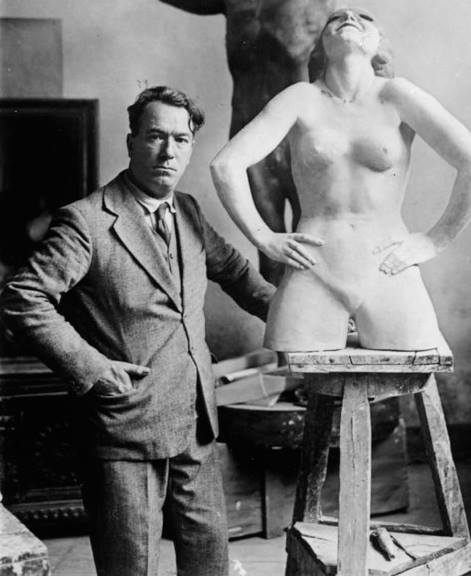Il Museo dell’Opera di Guido Calori è ospitato all’interno del suggestivo chiostro del seicentesco palazzo che fu convento delle Clarisse di San Gemini, situato nel punto più elevato del paese, nel Rione Rocca.
L’intero complesso, comprendente anche la piccola Chiesa di Santa Caterina, si snoda tra la medievale via del Tribunale e le mura castellane. La collezione, conservata nel Museo, raccoglie le opere pittoriche e scultoree di Guido Calori (oltre all’archivio, i disegni, i bozzetti e gli strumenti di lavoro) che erano conservate presso i suoi studi romani.
La collezione e l’edificio che la ospita, di recente interamente restaurato, sono stati dichiarati, nel 1990, d’eccezionale valore storico-culturale e dunque sottoposti a vincolo da parte della Soprintendenza ai beni artistici; nel 1992 anche l’archivio è stato tutelato per la sua indubbia importanza.
Oggi, a distanza di circa quindici anni dalla prima apertura al pubblico, si propone un più attento studio dell’opera del maestro ed un progetto articolato per la tutela e valorizzazione dell’intero complesso.
Orari:
Aperto al pubblico il sabato,la domenica e i festivi:
10.00 – 14.00
Per visite guidate: FONDAZIONE CALORI (tel. 0744 630114); PROLOCO SAN GEMINI (tel. 0744 630130)
The Museum of Guido Calori is housed in the cloister of the seventeenth centurypalace that was once the convent of Poor Clares of San Gemini, located on the highest point of the country, in the District Rocca.
The entire complex, which also includes the small Church of Santa Caterina, the medieval street runs between the Court and the city walls. The collection,preserved in the Museum, collects paintings and sculptures by Guido Calori (in addition to the archive, drawings, sketches and working tools) that had been kept at his studies in Rome.
The collection and the building that houses have recently been completelyrestored, has been declared, in 1990, of great historical value and thereforesubject to constraint by the Superintendent of artistic heritage, in 1992 the archivewas protected for its undoubted importance.
Today, at a distance of about fifteen years after first opening to the public, we propose a more careful study of the master and a complex project for the protection and enhancement of the entire complex.
Hours:
Saturday and Sunday:
10:00 to 14:00, 17:00 to 20:00
closed Monday
Tuesday to Friday: 17:00 to 20:00
free admission
The Museum of Guido Calori is housed in the cloister of the seventeenth centurypalace that was once the convent of Poor Clares of San Gemini, located on the highest point of the country, in the District Rocca.
The entire complex, which also includes the small Church of Santa Caterina, the medieval street runs between the Court and the city walls. The collection,preserved in the Museum, collects paintings and sculptures by Guido Calori (in addition to the archive, drawings, sketches and working tools) that had been kept at his studies in Rome.
The collection and the building that houses have recently been completelyrestored, has been declared, in 1990, of great historical value and thereforesubject to constraint by the Superintendent of artistic heritage, in 1992 the archivewas protected for its undoubted importance.
Today, at a distance of about fifteen years after first opening to the public, we propose a more careful study of the master and a complex project for the protection and enhancement of the entire complex.
Hours:
Saturday and Sunday:
10:00 to 14:00, 17:00 to 20:00
closed Monday
Tuesday to Friday: 17:00 to 20:00
free admission
The Museum of Guido Calori is housed in the cloister of the seventeenth centurypalace that was once the convent of Poor Clares of San Gemini, located on the highest point of the country, in the District Rocca.
The entire complex, which also includes the small Church of Santa Caterina, the medieval street runs between the Court and the city walls. The collection,preserved in the Museum, collects paintings and sculptures by Guido Calori (in addition to the archive, drawings, sketches and working tools) that had been kept at his studies in Rome.
The collection and the building that houses have recently been completelyrestored, has been declared, in 1990, of great historical value and thereforesubject to constraint by the Superintendent of artistic heritage, in 1992 the archivewas protected for its undoubted importance.
Today, at a distance of about fifteen years after first opening to the public, we propose a more careful study of the master and a complex project for the protection and enhancement of the entire complex.
Hours:
Saturday and Sunday:
10:00 to 14:00, 17:00 to 20:00
closed Monday
Tuesday to Friday: 17:00 to 20:00
free admission
The Museum of Guido Calori is housed in the cloister of the seventeenth centurypalace that was once the convent of Poor Clares of San Gemini, located on the highest point of the country, in the District Rocca.
The entire complex, which also includes the small Church of Santa Caterina, the medieval street runs between the Court and the city walls. The collection,preserved in the Museum, collects paintings and sculptures by Guido Calori (in addition to the archive, drawings, sketches and working tools) that had been kept at his studies in Rome.
The collection and the building that houses have recently been completelyrestored, has been declared, in 1990, of great historical value and thereforesubject to constraint by the Superintendent of artistic heritage, in 1992 the archivewas protected for its undoubted importance.
Today, at a distance of about fifteen years after first opening to the public, we propose a more careful study of the master and a complex project for the protection and enhancement of the entire complex.
Hours:
Saturday and Sunday:
10:00 to 14:00, 17:00 to 20:00
closed Monday
Tuesday to Friday: 17:00 to 20:00
free admission



Comment (0)